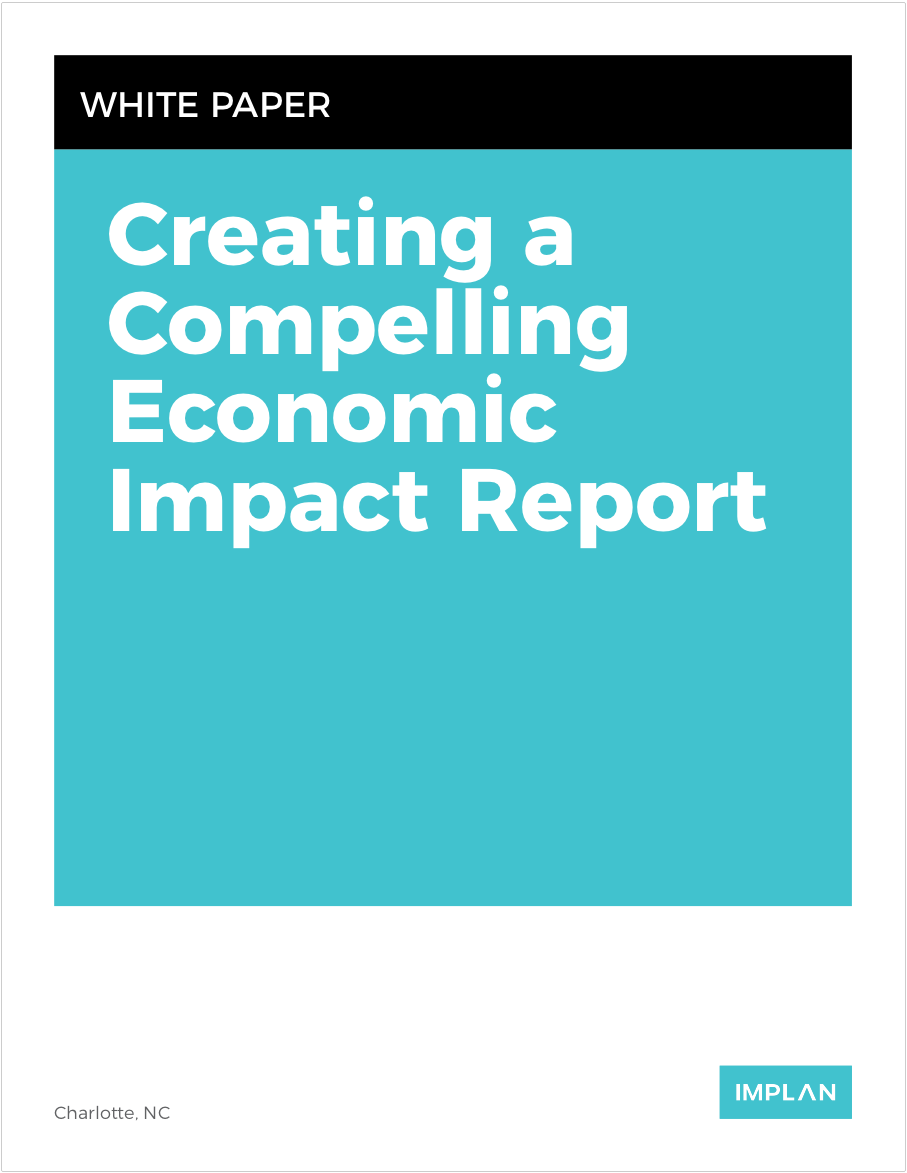Economists use the name “IMPLAN” to refer to both the company’s software and data. The impact analysis data takes the software and company as its namesake (distinct from IMPLAN’s CEW, Occupational Employment and Compensation Matrices, and other data products) mainly because, though fastidiously true to its sources, the data in form and function is ultimately unique to the economic impact modeling world.
The IMPLAN data relies on its own 536-sector scheme—based on NAICS sectors—which groups firms that share similar spending patterns. A benefit of this scheme is that it also allows for added detail for energy sectors which are not available from federal data sources, and allows the user to define study geographies (including national, state, congressional district, county, metropolitan statistical areas (MSAs), and zip codes).
IMPLAN aims to strike a balance between data that’s most recently released and a data set for the model that is the most complete (read: makes the fewest number of estimations as possible).
This aims to mitigate an inescapable reality of the data sources: their release dates are sometimes unpredictable. There are times when IMPLAN data sources revise data that they’ve previously released over the course of a year and issue multiple updated versions. In some cases, the public release of the data is lagged by a year or more from the time of collection. Here’s how all of these factors get sorted out in the data:
 The analysis is only one part of the whole story. To learn more about other presentation and storytelling techniques and the must-have sections to include in a report, check out our white paper “Creating a Compelling Economic Impact Report.”
The analysis is only one part of the whole story. To learn more about other presentation and storytelling techniques and the must-have sections to include in a report, check out our white paper “Creating a Compelling Economic Impact Report.”IMPLAN Data Overview
Constructing the annual IMPLAN datasets requires gathering data from numerous sources, estimating missing data elements, and converting them to a consistent year and sectoring scheme, all while benchmarking them against other data to maintain accuracy. Construction of the annual IMPLAN datasets requires the use of roughly 100 datasets, each of which may contain multiple files and tables. IMPLAN adds value to publicly available data by:
- Providing estimates for non-disclosed data.
- Providing estimates for non-census and non-survey years.
- Disaggregation into finer geographic scales.
- Disaggregation into finer sector detail.
- Projecting lagged raw data.
Additionally, IMPLAN provides inter-county trade flow data for which there are no raw data sources. This is done using a calibrated and constrained gravity model. These trade flow data (along with commuting data) allow for multi-regional input-output (MRIO) analysis. This shows the effects of economic activity in one region across any number of linked regions.
Production Functions
The U.S. production functions, i.e., the list of intermediate goods and services used by an industry to produce its output, are based on the Bureau of Economic Analysis’s (BEA) benchmark input-output (I-O) tables (released every 5 years). The U.S. gross absorption coefficients are adjusted to sum to new output and value-added totals each year.
- We start with the latest BEA Benchmark I-O tables.
- We derive current industry output, value added, and final demands. Value added and final demands each are equal to GDP by definition.
- Using the benchmark byproducts and the current industry output, we derive current commodity output.
- Multiplying the current industry output by the benchmark absorption vector gives us a first approximation of the current Use Matrix (i.e., current production functions).
- The columns of the current Use Matrix are forced to sum to industry output - value added (columns).
- Then the rows of the current Use Matrix are forced to sum to the commodity output - final demand control totals (rows). This will be the first time the proportions of the columns change.
- This is repeated until no further adjustment is needed.
To obtain sub-national absorption coefficients, the national absorption coefficients are adjusted to match regional value added-to-output ratios. The assumption is that the local data are correct and the national coefficients need to adjust to fit the local situation. Applying the trade flow assumptions, i.e., the rate at which each good and service is procured locally, will then further modify the regional absorption coefficients by removing the imports (which vary by region and year).
Employment and Earnings
In general, Bureau of Labor and Statistics’ (BLS) annual totals from the Quarterly Census of Employment and Wages (QCEW) data provide the county-level industry structure for the IMPLAN database. The Census Bureau’s County Business Patterns (CBP) data, along with other data, are used to estimate values for non-disclosed data. QCEW and CBP include only wage and salary (W&S) employment and income data. Projected BEA Regional Economic Accounts (REA) data are used to incorporate proprietors, non-covered sectors, and supplements to wages.
Value Added
Other property income (OPI) primarily consists of corporate income and depreciation, and is one of the most difficult items to estimate. The BEA releases state-level 3-digit NAICS GDP data, which include the break-out of GDP into employee compensation (EC), Taxes on production and imports (TOPI), and gross operating surplus (GOS). GOS includes both proprietor income (PI) and OPI, so OPI for each 3-digit NAICS sector is derived by subtracting our estimate of PI from GOS. These control values are distributed to IMPLAN industries based on the BEA benchmark I-O characteristics for GOS.
Output
In IMPLAN, total industry output (TIO) is the value of annual calendar year production. It can be measured either as the total value of purchases by intermediate and final consumers or as intermediate outlay plus value-added. Output data for most sectors come from the BEA’s Annual Industry Accounts and the Annual Survey of Manufacturers. Retail output data come from the U.S. Census Bureau’s Annual Census of Retail Trade. Certain other sectors use information from various other surveys and censuses.
Personal Consumption Expenditures (PCE)
- Annual and current.
- National level.
- Only one spending pattern (i.e., not separated by income class).
- Roughly 100 expenditure categories. The BEA benchmark I-O is used to distribute these expenditure categories among IMPLAN sectors.
- The PCE data are in purchaser prices, so margining and re-sectoring are necessary to obtain producer prices for use in IMPLAN.
Census Bureau Consumer Expenditure Survey (CES) Data
- Annual but lagged.
- National level.
- Gives us expenditures by income class (we then control these to the NIPA PCE totals).
Institutions
Households
National PCE estimates are distributed to states and counties based on state- and county-level households-by-income-class data and spending-by-income-class data.
Government
Federal sales and expenditure data are estimated using NIPA control totals and the benchmark I-O distribution, with the exception of timber sales data, which come directly from the U.S. Forest Service. Data for state and local government sales are obtained from the current Annual Survey of State and Local Governments Finances data series, while state and local government expenditures are estimated using NIPA control totals and the benchmark I-O distribution.
Inventory
For the manufacturing sectors, the Annual Survey of Manufacturers provides inventory data. Inventory for other sectors are derived from benchmark I-O ratios.
Imports/Exports
For the U.S., data for foreign imports and exports of shippable commodities come from the U.S. Census Bureau. Foreign imports and exports of services are based on the BEA benchmark I-O controlled to current NIPA import and export totals, respectively.
After accounting for foreign trade, the gravity-based trade flow or econometric model is used to determine domestic trade (trade among states and counties).
Capital
BEA data provide total capital expenditures by commodity, grouped by private investment, federal government investment, and state and local government investment. The national data are distributed to states and counties based on output in the construction industries.
Wrapping it up
As always, there’s way more to learn more about the data. Visit our resources and support sites where you’ll find even more detail and vibrant discussion in the online community. To learn more about how this data can be applied, download "Alternative Data for Alpha: Analyzing Economic Impact, Structure, and Supply Chain Risk Factors."



.png?width=80&name=IMPLAN_Logo_Print-Vector_NEW%20(2).png) Copyright 2025
Copyright 2025